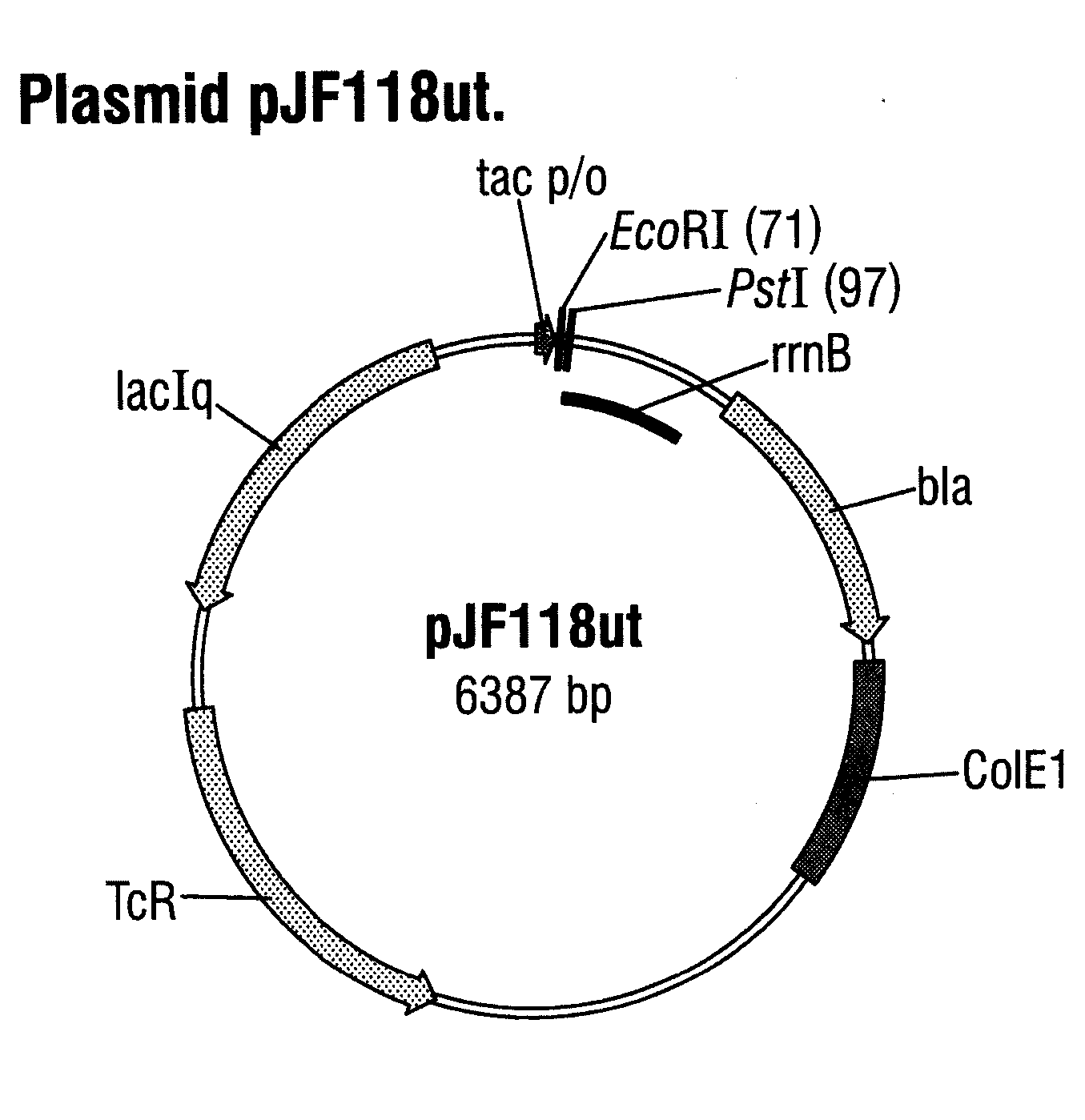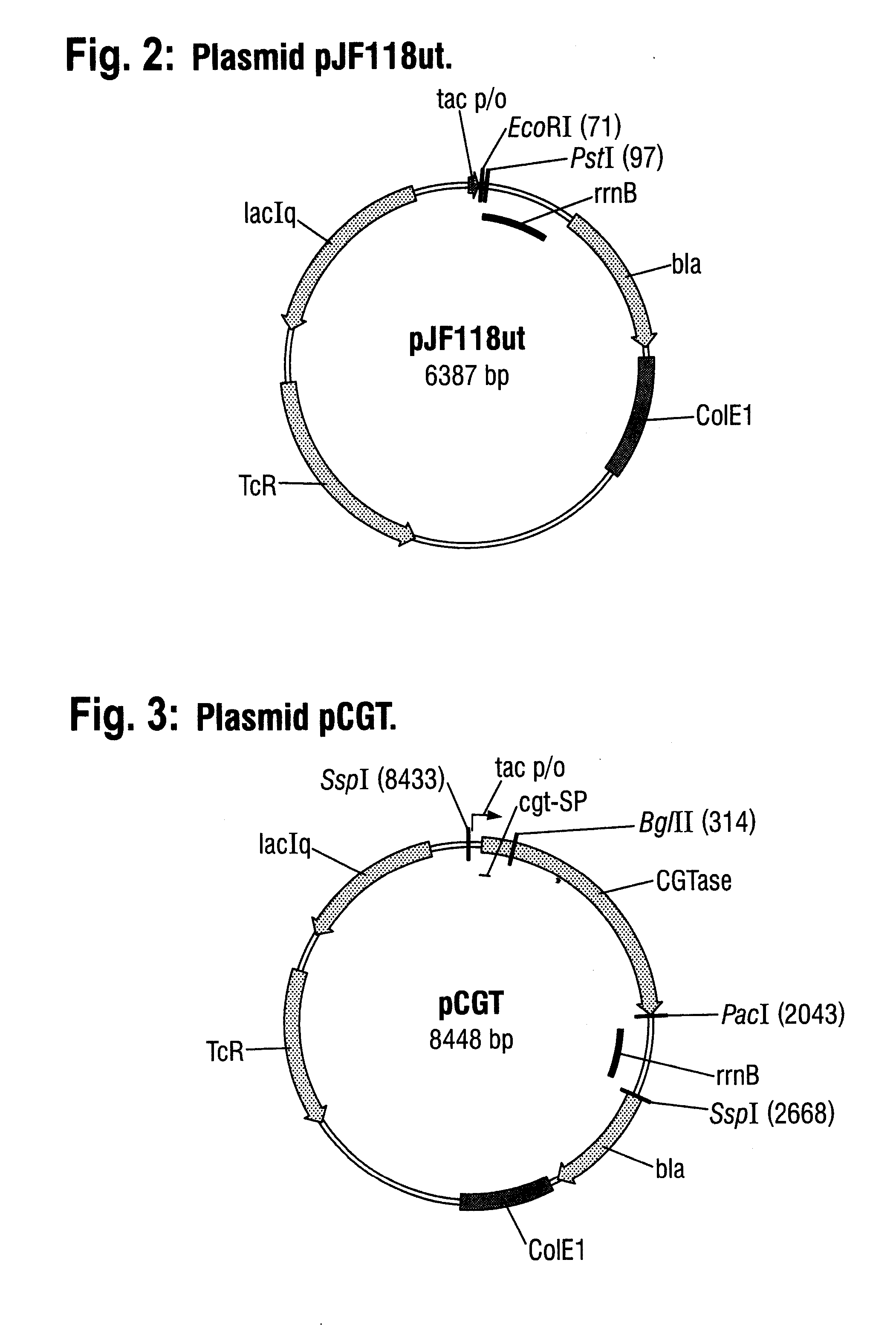Signal peptide for the production of recombinant proteins
a technology of recombinant proteins and signal peptides, which is applied in the direction of peptides, peptide/protein ingredients, peptide sources, etc., can solve the problems of laborious preparation of the periplasm or disintegration of cells, fewer host proteins in crude products, and laborious production of crude products
- Summary
- Abstract
- Description
- Claims
- Application Information
AI Technical Summary
Problems solved by technology
Method used
Image
Examples
example 1
Creation of a Signal Sequence According to the Invention and a Vector According to the Invention
[0058] As the starting plasmid, the plasmid pCGT was created as follows:
[0059] A DNA fragment with the SEQ ID NO: 4, which contains a cyclodextrin glycosyltransferase (CGTase) gene from Klebsiella pneumoniae M5a1 (Gene bank No. M15264), was prepared by gene synthesis. This DNA fragment was cloned into the expression vector pJF118ut (FIG. 2), which has been deposited at the DSMZ—Deutsche Sammlung von Mikroorganismen und Zellkulturen GmbH [German Collection of Microorganisms and Cell Cultures](Braunschweig) under the number DSM 18596. pJF118ut is a derivative of the known expression vector pKK223-3 (Amersham Pharmacia Biotech) and in addition to the β-lactamase gene and the tetracycline resistance gene also contains the tac promoter, which is repressed by the LacIq gene product, the gene whereof is also present on the plasmid, and which can be switched on by an inducer, such as for exampl...
example 2
Increasing Interferon Production by Use of the Signal Sequence According to the Invention
[0070] Plasmid pKP651 (phoA signal sequence), pKP652 (ompA signal sequence), pKPIFN (cgt signal sequence) and pBaBIFN1 (AFA signal sequence according to the invention)(see Example 1) were introduced into strain WCM105 (preparable according to EP0338410B1) by transformation by standard methods (by CaCl2 transformation). Plasmid-containing strains were selected using ampicillin (100 mg / L).
The following strains were obtained:
[0071] WCM105 / pKP651 (phoA signal sequence)
[0072] WCM105 / pKP652 (ompA signal sequence)
[0073] WCM105 / pKPIFN (cgt signal sequence)
[0074] WCM105 / pBaBIFN1 (AFA signal sequence)
[0075] The production of interferon.2b in the resulting strains was studied. For this, the strains were cultured in 10 ml of LB medium containing 100 mg / L of ampicillin and with 1% glucose at 30° C. At an optical density of 0.5 at 600 nm (OD600), the production of interferon.2b was induced by addition...
example 3
Creation of an Improved CGTAse Production Plasmid by the Insertion of the Signal Sequence According to the Invention
[0081] The plasmid pCGT (see Example 1) bears the gene for a CGTase in-frame fused to the signal sequence for the CGTase. This signal sequence was now replaced by the signal sequence according to the invention.
[0082] For this, the 8448 bp plasmid was cleaved with the restriction enzymes SspI and BglII in a partial digestion by methods known to the person skilled in the art. The 8119 bp fragment was isolated and treated with Klenow enzyme, whereby the ends were smoothed. The 329 bp fragment, which contains the CGTase signal sequence and about 150 bp of the 5′ end of the CGTase gene, was removed.
[0083] The following 329 bp DNA fragment, which is identical to the aforesaid fragment as regards sequence, except that the CGTase signal sequence has been replaced by the signal sequence according to the invention, was prepared by gene synthesis:
SEQ ID NO: 11ATTCTGAAATGAGCT...
PUM
| Property | Measurement | Unit |
|---|---|---|
| temperature | aaaaa | aaaaa |
| temperature | aaaaa | aaaaa |
| optical density | aaaaa | aaaaa |
Abstract
Description
Claims
Application Information
 Login to View More
Login to View More - R&D
- Intellectual Property
- Life Sciences
- Materials
- Tech Scout
- Unparalleled Data Quality
- Higher Quality Content
- 60% Fewer Hallucinations
Browse by: Latest US Patents, China's latest patents, Technical Efficacy Thesaurus, Application Domain, Technology Topic, Popular Technical Reports.
© 2025 PatSnap. All rights reserved.Legal|Privacy policy|Modern Slavery Act Transparency Statement|Sitemap|About US| Contact US: help@patsnap.com



